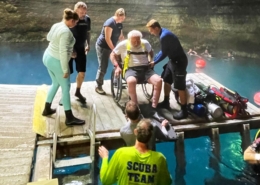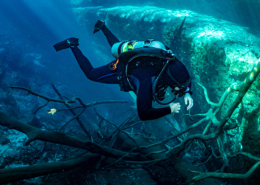Wreck Diving: Do’s and Don’ts
By Brian Shreve
Dropping down the line, it seems like forever. Nothing below you, and nothing above you. Only the sounds of you and your buddy’s exhaled bubbles break the silence. Suddenly, you can make out a faint outline, and then all at once, the wreck looms into view. This is awesome!
Those were my thoughts on my very first wreck diving trip over 15 years ago, and from that point on, I was hooked! Along the way, I’ve learned a few things diving wrecks, and teaching wreck diving. I thought I’d share a list of some basic do’s and don’ts for divers new to wreck diving, whether those wrecks are in sport diving depths or require advanced CCR trimix to safely dive. No way this list is all-inclusive, but it’s a good start.
Equipment is key
First, do make sure that your dive equipment is in top condition and ready to go before the trip. Many wrecks are a good distance offshore and involve a boat ride to access them. The last thing you want is to have a piece of key equipment malfunction over the dive site and lose a day of diving because of it. And don’t go cheap on equipment for wreck diving. A lot of wrecks are at deeper depths, and a high-performance regulator should be tops on your list of equipment purchases. The old adage of “buy once, cry once” is never truer than when purchasing your life support equipment!
The only thing worse than broken gear is not having a critical piece of equipment, so do use a check list when packing. Be sure to include the gear you’ll need, and possibly a few spare parts for those easy-to-fix issues like tank o-rings, mask straps, fins straps, and so forth. And don’t be “that guy” – you know, the one that shows up with everything but the kitchen sink in 14 gear totes and takes up half the boat with no regard for other divers or their space needs. Bring only what you need, reasonable spares, and perhaps a small tool kit. Leave the second BCD, the third DPV, and the bubble gun, at home.
But don’t forget that specialized gear! Wreck diving, especially if you’re penetrating (more on that in a moment), will require a few additional pieces in your kit that an open water dive doesn’t. So, do make sure you’ve brought your reel (and a backup too), cutting devices, lights, and your surface marker buoy (SMB). Wrecks are often found in deeper water, currents and rough seas may be an issue, and many natural wrecks are found in shipping lanes where traffic is a concern. Local conditions vary widely, so don’t ignore the dive briefing. Your boat crew knows what procedures work in their area, so do as they suggest. If trail, tag (aka granny), and down lines are provided, do use them, so that you don’t get blown off the wreck during the descent or ascent. If hot dropping a wreck, do make sure you’re completely ready to go before entering the water, so that you don’t miss the wreck! Use of SMBs is standard procedure in some areas for ascents, so do become proficient in their use. It’s best to practice SMB use and become proficient with them prior to needing to use them on a deep wreck in strong current.
Proper training is paramount
We’ve all heard as open water divers that we should avoid any overhead environments. That is definitely true with wrecks, so don’t penetrate into overhead environments unless you’re properly equipped and properly trained. Proper training, such as the SDI Wreck Diver Specialty, is readily available and will teach you to recognize the hazards associated with wreck diving and by use of proper techniques and equipment, to manage those risks. For more advanced divers, the TDI Advanced Wreck Diver course will continue your training into the technical realm. So, do seek out proper training from qualified professionals, and build your experience gradually. There’s nothing on a wreck worth risking your life for, and the wreck will always be there another day, so do stay within the limits of you and your buddy’s training, experience, and comfort level. In other words, don’t forget the “golden rule” – any diver can call the dive at any time for any reason.
Successful dives start with good planning, so do research the wreck. Often times, wrecks are simply too large to fully explore in one dive. Learning about the wreck’s layout can help you pinpoint those areas of interest for the dive, as well as identify potential hazards. Research will also reveal depth profiles so you can lay out likely dive plans and contingencies. Talking to other divers who’ve been on the wreck is a good start and many divers share videos of the wrecks they’ve been on through YouTube and other social media. For many wreck divers, myself included, researching the wreck can be almost as much fun as actually diving it!
The payoff
Wreck diving can serve as a glimpse into the past. Many shipwrecks still contain the cargo, crew’s belongings, and other artifacts from the day they went down. Whether you dive on wrecks to explore that history, view the life that inhabits an artificial reef, or for the dramatic backdrop that wrecks can provide the underwater photographer or videographer, don’t forget to have fun and dive safe! Feel free to expand this list by adding your own do’s and don’ts in the comments section below.










發表評論
想加入討論?隨時歡迎參與討論!